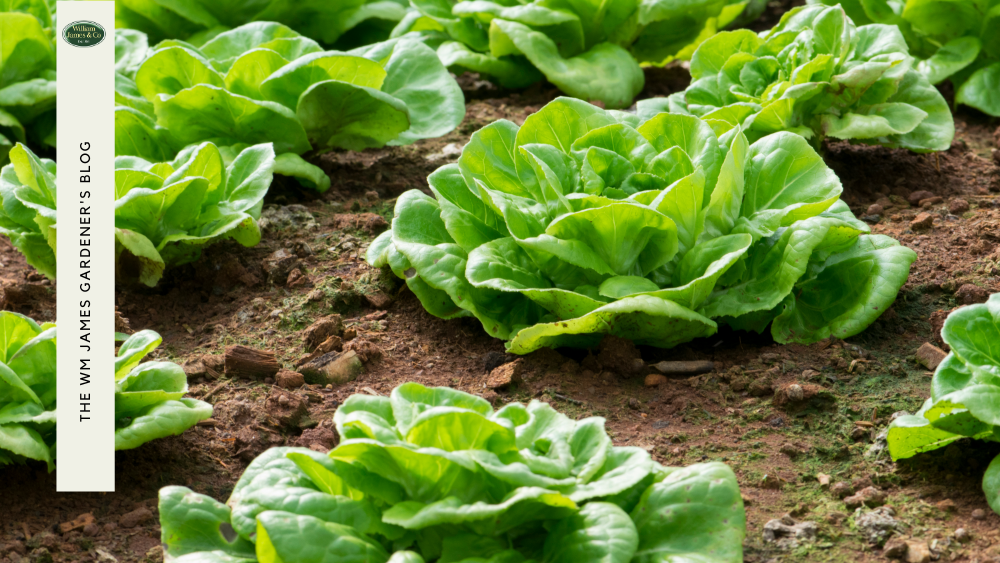We use cookies to make your experience better. To comply with the new e-Privacy directive, we need to ask for your consent to set the cookies. Learn more.
8 Best Vegetables to Grow in July
- Admin
- WM James Gardening Blog
- 25 Mar 2024
-
79views

July is a prime time for gardeners to start sowing seeds that will flourish in the warmth of late summer and early autumn.
Whether you're an experienced gardener looking to expand your crop variety or a beginner eager to test your green thumb, there are plenty of vegetables that thrive when planted mid-summer.
From seasonal root vegetables that relish the cooler, underground conditions to leafy greens that love the long, sunny days, there's a wide range of produce to choose from.
Here are eight of the best vegetables to grow in July.
|
In this guide, we'll look at:
|
The Essential Veg Growing Calendar for UK Gardeners
8 Easiest Vegetables to Plant in July
In the UK, July is the perfect time to plant a variety of vegetables. We've selected 8 of the simplest ones you can grow in your vegetable patch for a bountiful harvest from late summer through autumn.
| Vegetables to Grow in July | When to Harvest |
|---|---|
| Lettuce | 8-12 weeks after germination. A firm heart should have formed |
| Pak Choi | From 30 days for baby leaves |
| Turnips | 8-10 weeks, depending on variety |
| Pickling Cucumbers | When they reach 2-3 inches long |
| Radishes | From 4 weeks. Roots should be 2.5cm in diameter |
| Dwarf French Beans | When pods reach 10cm long |
| Perpetual Spinach | 55-65 days after planting. Harvest outer leaves only |
| Winter Cabbages | 20 weeks after planting. Use a sharp knife to cut at the base |
1. Lettuce
Planting lettuce in July can yield a quick and abundant harvest, making it an ideal choice for those looking to enjoy fresh, home-grown greens.
The key to successful lettuce growth in the warmer month of July revolves around selecting heat-tolerant varieties and ensuring they receive plenty of water to keep the soil cool and moist.
|
Heat-tolerant lettuce varieties include:
|
Positioning your lettuce plants in a spot that gets partial shade can help protect them from the harsh midday sun, which can be too intense and lead to bolting or wilting.
2. Pak Choi
Pak Choi is an exceptional choice for gardeners to plant in July due to its rapid growth cycle and resilience to varying weather conditions.
This leafy green can go from seed to harvest in as little as 30 to 45 days, making it perfect for those looking to add a fast-growing vegetable to their summer garden.
Also, pak choi appreciates the warmer temperatures of July, which can often accelerate its growth, allowing gardeners to enjoy its crisp, tender leaves sooner.
Its ability to withstand both warm days and cooler evenings makes it a versatile crop for the mid-summer garden.
3. Turnips
Turnips are an outstanding choice for July planting due to their dual-purpose nature; both their roots and greens are edible, offering gardeners a versatile crop.
The cooler part of the summer is perfect for turnip growth, as they thrive in the milder temperatures that July evenings can offer.
Planting turnips in July allows them to mature in cooler autumn conditions, which is ideal for enhancing their flavour.
Depending on the variety, you can expect to harvest turnips approximately 6 to 10 weeks after planting, allowing for both early autumnal harvesting of the roots and potentially earlier harvesting of the greens, should you wish to enjoy them fresh in salads or cooked dishes.
4. Pickling Cucumbers
Planting pickling cucumbers in July is an excellent idea for several reasons. This period allows them to thrive in the warm summer weather, contributing to speedy growth and an abundant harvest.
The warmth of July is particularly conducive to the development of these cucumbers, ensuring that they achieve the perfect size and taste for pickling.
Starting them in July means you can enjoy harvesting your cucumbers late in the summer or early autumn, just in time for a pickling session to preserve your summer flavours.
|
Pickling cucumbers planted at this time are less likely to encounter the diseases and pests prevalent in early spring, leading to healthier plants and more successful yields. |
5. Radishes
Radishes present an excellent opportunity for gardeners to plant in July, as they are one of the fastest vegetables to mature, with some varieties ready to harvest in as little as four weeks. This quick turnaround makes them an ideal choice for those looking to achieve a rapid yield.
Due to their hardiness, radishes can be sown directly into the soil in July, thriving in the summertime warmth while benefiting from the cooler nights. This balance helps develop their crisp texture and zesty flavour.
Gardeners can enjoy a continuous harvest by planting successive crops every two weeks throughout July and into early August.
|
Here's a selection of radish varieties known for their flavour and ease of cultivation:
|
6. Dwarf French Beans
Dwarf French beans are an outstanding addition to a July-planted vegetable garden due to their compact nature and impressive productivity.
Opting for a July sowing provides the ideal balance of warm, rich soil and mid-summer weather, fostering swift germination and vigorous growth.
These beans are particularly suited for smaller gardens or containers, requiring less space than their climbing counterparts while still yielding a bountiful harvest.
The warmth of July days accelerates their growth, allowing gardeners to enjoy harvesting tender, flavourful beans from late summer through to early autumn.
How to Grow Container Vegetables
7. Perpetual Spinach
Perpetual spinach is a versatile and resilient leafy green, making it a superb choice for planting in July.
Its robust nature allows it to thrive in varying weather conditions, from the warm days of summer to the cooler temperatures as autumn approaches.
Home gardeners will appreciate perpetual spinach for its minimal maintenance requirement and its continuous yield.
Unlike traditional spinach, which may bolt in the heat, perpetual spinach remains productive throughout the summer and into autumn, providing a continuous harvest.
Gardeners can expect to start picking leaves as early as 7 to 8 weeks after planting, with the harvest persisting until the first frosts of winter.
8. Winter Cabbages
Planting winter cabbages in July is strategic for ensuring a continuous supply of fresh greens throughout the colder months.
This timing takes advantage of the remaining warmth of summer to establish robust plants capable of withstanding the winter.
Planting in July allows the cabbages to mature enough to survive the first frosts, with the cooler autumn weather sweetening the leaves, enhancing their flavour by the time they're ready to harvest.
The slow-growing nature of winter cabbages means they need this early start to fully develop, providing lush, dense heads during a time when fresh, homegrown vegetables might otherwise be scarce.
|
Here's a selection of winter cabbage varieties known for their resilience and flavour:
|
Our Top Tips for July Sowing
To help you make the most out of your July planting, we’ve compiled some of our top tips for sowing these hardy winter greens.
Protect Heavily-Laden Vertical Growers
Heavily-laden vertical growers like tomatoes and runner beans need extra support to thrive, especially when bearing fruit.
Staking these plants can help prevent them from bending, breaking or becoming damaged by strong winds.
When staking, insert a stake near the plant's base at planting, avoiding root damage. Secure with ties allowing room for growth.
Our Bean & Pea Ring is great for supporting vertical growers in pots, while our Bamboo Canes For Plant Support Structures are ideal for providing support to vertical growers planted in a row.
Be Vigilant of Pests
July marks the peak of summer, leading to a surge in garden pests, like aphids and slugs, due to warm conditions. You’ll want to use preventative methods to keep these creatures at bay.
We always recommend using garden plant netting as an easy and effective way to protect your produce.
Our 20mm Black General-Purpose Garden Netting is ideal for keeping common garden birds like sparrows, pigeons, and starlings away from your growing crops while still allowing pollinators access.
To protect your plants from smaller pests, like aphids and carrot fly, our Fine Insect Garden Netting is a solid choice. The 1.35mm mesh size is small enough to keep these tiny insects out, while still allowing air and water to flow through.
Regularly Check for Disease
Gardeners should regularly inspect their July plants for disease signs, as warmer, humid conditions can accelerate disease spread.
Early identification allows for prompt treatment, preventing widespread infection and crop loss. This vigilant approach ensures the health and vitality of the vegetable garden, securing a bountiful harvest.
Summary: Growing Vegetables in July
July offers a golden opportunity for gardeners to enrich their vegetable patches with a diverse selection of resilient and rewarding crops.
From the rapid growth of pak choi to the sturdy winter cabbages, each vegetable stands as a testament to the joys of summer planting. This green-fingered venture not only promises a luscious harvest but also a connection to the rhythms of nature.
If you're keen to explore more gardening insights, check out the rest of our series of month-by-month growing blogs to unlock the secrets to thriving gardens year-round!
FAQs
What Are the Easiest Vegetables to Grow in Summer?
Some of the easiest vegetables to grow in summer include
- Tomatoes
- Courgettes
- Beans
- Chilli peppers
These crops thrive in warmer temperatures and, with regular watering and basic care, can produce abundant yields.
Additionally, herbs like basil and coriander also flourish in the summer months, making them perfect additions to a summer vegetable garden.
How Do You Plant Vegetables in July?
To plant vegetables in July, start by choosing suitable, fast-growing varieties. Prepare the soil with compost and ensure it's well-drained. Sow seeds directly into the ground or plant seedlings, spacing them according to their size at maturity. Water them thoroughly upon planting and regularly thereafter.
Is July Too Late to Plant Vegetables in the UK?
In the UK, July is not too late to plant vegetables. Quick-growing, late-season crops like salad leaves, radishes, and some herbs can still be sown.
Additionally, planting overwintering crops such as kale, brussels sprouts, and winter salads ensures a productive garden.
What Fruit Can You Grow in July?
In July, you can successfully plant strawberries, raspberries, and blackberries. These fruits start well from runners or young plants and will establish themselves quickly in warm weather.
Also, consider planting rhubarb crowns as they can thrive when planted during this time, ensuring a harvest for the following year.
Can I Plant Tomatoes in July in the UK?
Planting tomatoes in July in the UK is possible, but they should be well-established plants rather than seeds. Opt for quick-growing varieties and keep them in a warm, sunny spot to ensure they have enough time to mature and produce fruit before the cooler weather arrives.





















